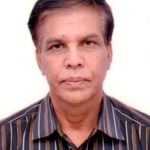Chair:
Duggirala Pallamraju (India), 2024 – 2028
Vice-Chairs:
P.R. Fagundes (Brazil), 2022 – 2026* (fagundes – at – univap.br)
David Themens (United Kingdom), 2024 – 2028
Erdal Yigit (USA), 2024 – 2028*
Intercommission/Panel/Task Group Liaisons:
SC A: Taylor, M. (USA), 2018 – 2022
SC B: Sotin, C. (USA), 2016 – 2020
SC D: Yau, A. (Canada), 2018 – 2022
SC E: Swain, M.R. (USA), 2016 – 2020
PCB: Asti Bhatt (USA), 2022 – 2026
PCB: Katariina Nykyri (USA), 2022 – 2026
PRBEM: Paul T. O’Brien (USA), 2018 – 2022
PSW: Norbert Jakowski (Germany), 2022 – 2026
Terms of Reference:
The Commission stimulates planning of cooperative research program; investigates specified aspects of the properties and structure of the upper atmospheres of the Earth and planets; plans symposia and topical meetings in which new results are presented and discussed, and develops comprehensive reference atmospheres and ionospheres for the Earth and planets.
Sub-Commission C1: The Earth’s Upper Atmosphere and Ionosphere
Chair:
Yuichi Otsuka (Japan), 2024 – 2028* |
|
|
Vice-Chair:
Claudia Stolle (Germany), 2024 – 2028*
Kavutarapu Venkatesh (India), 2024 – 2028
Shunrong Zhang (USA), 2024 – 2028
|
|
Terms of Reference
The Ionosphere, Thermosphere, and Mesosphere (ITM) is the region that extends between approximately 90 and 800 km in altitude and it continues to be an arena of active international space-based and ground-based research. The density, composition, and dynamics of this region are very responsive to direct energy inputs and their variations from the Sun, the magnetosphere (high latitudes), and the middle atmosphere. The ionosphere is created by the interaction of solar extreme ultraviolet (EUV) radiation with the upper atmosphere and it extends from about 60 km above the Earth’s surface to several thousand km. At high latitudes, energetic electrons precipitate into the lower ionosphere and create additional highly variable ionized regions. The ionized and neutral gases are closely linked through collisions and dynamics, responding to energy and momentum forcers from both the magnetosphere above and the atmosphere below.
Study methods for the ITM include ground optical and radio waves, sounding rockets, and satellite platforms. Increasingly, research activity has been organized beyond individual or national investigations into large, international, focused study projects. For example, in the 1990’s, research was coordinated with the Solar Terrestrial Energy Program (STEP) and with the Coupling, Energetics and Dynamics of Atmospheric Regions (CEDAR) programs. From 1998 through 2002, the Scientific Committee for Solar Terrestrial Physics (SCOSTEP) SRAMP (STEP Results, Applications and Modelling Phase) program and the PSMOS (Planetary-scale Mesopause Observing System) program were active. The EPIC (Equatorial Processes Including Coupling) program studied the ITM coupling processes at low latitudes. These programs worked in conjunction with the International Solar Cycle Study (ISCS) program that was also under the direction of SRAMP. Since 2002 SCOSTEP has evaluated the successes of previous programs and, with the recognition of space weather (the highly variable impact of the Sun’s photons, particles, and fields upon the Earth and our technological systems) it is implementing a major new program. This program is called Climate and Weather of the Sun-Earth System (CAWSES) and is implemented in the period 2004-2008. The intent of these programs is, in part, to provide a global network of observing systems and study projects to understand the Sun’s affects upon the Earth’s ITM and to determine the global scale solar, chemical, and dynamical influences on the ITM region.
Back to top
Sub-Commission C2: The Earth’s Middle Atmosphere and Lower Ionosphere
Chair:
Irina Strelnikova (Germany), 2024 – 2028 |
|
Vice-Chair:
Robin Wing (Germany), 2024 – 2028 |
|
Terms of Reference
The “Middle Atmosphere and Lower Ionosphere (20 – 110 km)” is the focus of extremely active research, involving groups in all the major nations of the world which engage in atmospheric and space research. Much of the work is coordinated with, or is consistent with, global research programs such as the post-STEP programs of SCOSTEP, SRAMP (Step Results, Applications, and Modelling Phase), PSMOS (Planetary Scale Mesopause Observing System), and EPIC (Equatorial Processes Including Coupling); and the “Coupling, Energetics and Dynamics of Atmospheric Regions” (CEDAR). Because the region contains the ozone layer, and will be involved in all aspects of Global Climate Change, this research is of enormous significance; it includes the SPARC program (Stratospheric Processes and their Role in Climate). The dominant themes are wave energy incoming from the lower atmosphere, wave interactions and momentum/energy dissipation within the region, and solar/magnetospheric influences from above; and the changes in chemical and physical aeronomy resulting from these dynamical processes. The Sub-Commission identifies and organizes symposia, workshops and topical meetings for COSPAR Scientific Assemblies; these respond to, but also provide leadership for new initiatives in research. In addition, it reports to the UN through COSPAR.
Back to top
Sub-Commission C3: Planetary Atmospheres and Aeronomy
 |
Chair:
Syed Haider (India), 2022 – 2026*
|
 |
Vice-Chair:
Takeshi Kuroda (Japan), 2024 – 2028*
|
Terms of Reference
COSPAR sub-commission C3 addresses the study of planetary atmospheres (including lower and upper neutral atmospheres, ionospheres, and magnetospheres) and associated aeronomical issues. An appropriate emphasis is placed upon recent spacecraft datasets and corresponding model simulations that provide interpretation. As our exploration of the solar system expands, the comparison of common features and processes across several planetary bodies is emerging as an important objective of this sub-commission.
Back to top
Task Group on Reference Atmospheres of Planets and Satellites (RAPS)
Chair:
Hilary Justh (USA), 2024 – 2028* |
|
Vice-Chair:
Roland Young (UAE), 2024 – 2028* (roland.young – at – uaeu.ac.ae) |
|
Back to top
URSI/COSPAR Task Group on the International Reference Ionosphere (IRI)
Chair:
Vladimir Truhlik (Czech Rep.), 2022 – 2026 (vtr – at – ufa.cas.cz) |
|
Vice-Chairs:
Ivan Galkin (USA), 2022 – 2026*
Andrzej Krankowski (Poland), 2022 – 2026* |
|
Terms of Reference
The Task Group was established to develop and improve a standard model of the ionospheric plasma parameters. The model should be primarily based on experimental evidence using all available ground and space data sources; theoretical considerations can be helpful in bridging data gaps and for internal consistency checks. Where discrepancies exist between different data sources the IRI team should promote critical discussion to establish the reliability of the different data bases. IRI should be updated as new data become available and as old data bases are fully evaluated and exploited. IRI is a joint working group of COSPAR (prime interest: a general description of the ionosphere for the evaluation of environmental effects on spacecraft and experiments) and URSI (prime interest: model of the electron density for defining the background ionosphere for radiowave propagation studies and applications). Visit the IRI homepage for further information.
Back to top
COSPAR/URSI Task Group on Reference Atmospheres, including ISO WG4 (CIRA)
Chair:
Sean Bruinsma (France), 2024 – 2028* (sean.bruinsma – at – cnes.fr) |
|
Vice-Chair:
Marcin Pilinski (USA), 2024 – 2028* |
|
Terms of Reference
The Task Group aims at developing and improving atmosphere models that are compatible with use in an operational environment, notably for satellite drag calculation. Presently, empirical upper atmosphere models are still used, but recently physics-based whole atmosphere models are being developed that potentially can be used in the near future.
New temperature, composition but mainly neutral density observations are necessary for model validation and assessment, as well as in data assimilation techniques. The derivation of the densities, and notably the aerodynamic modeling, must ideally be done according to a standard procedure in order to reduce if not eliminate inconsistencies when developing and evaluating models. The Task Group will work on improving and standardizing aerodynamic drag modeling.
The uncertainty of the predicted neutral density should in the future be provided as part of the model output. The model performance must be quantified according to an adopted standard testing procedure and metrics, such as provided by NASA/CCMC, taking the uncertainty into account. Carefully selected and continuously updated density datasets are used to compare to model predictions. The assessment is the basis for selection as CIRA model.
Back to top
Sub-Commission C5/D4: Theory and Observations of Active Experiments
Chair:
Asti Bhatt (USA), 2022 – 2026* |
|
Vice-Chair:
Eliana Nossa (USA), 2022 – 2026* |
|
Terms of Reference
The Sub-Commission on Active Experiments promotes research involving the active perturbation of laboratory plasmas as well as space plasmas to enhance the understanding of the natural space plasma environment and the interaction of space vehicles with this environment. Some of the active perturbations used in these investigations include (1) tethered satellites, (2) VLF transmitters, (3) charged particle beam injections (4) chemical releases and (5) high-power radio waves. A wide variety of diagnostics are used to isolate physical processes found in actively perturbed space plasmas. Ground-based space plasma experiments rely heavily on radar and optical observations. Space-based experiments rely on diagnostics such as in situ electric field and charged particle measurements. Important physical processes in space plasmas studied with active experiments include plasma turbulence, wave-particle interactions, wave-wave interactions, and plasma resonances. Physical processes studied associated with spacecraft environmental interactions include vehicle charging and plasma wakes and turbulence produced by vehicles passing through the charged media in space.
Back to top
* (after officer term) = second and final term in the office indicated